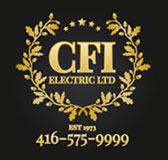How To Improve Your Interior/Exterior Lighting on a Budget
CFI ELECTRIC LTD. | Feb 03, 2021
There is no question that better lighting conditions in a studio aids with filming, and illuminating a workshop enhances product presentation. Additional lighting in your home will beautify the living room or basement.
Unfortunately, improving your home lighting can prove expensive. However, with a little research and proper planning, you can achieve stunning lighting without the astronomical price tag.
So, if you want to keep your interior/exterior lighting project between $1000 - $6000? Keep reading to learn a few tips and tricks from CFI Electric Ltd., Which will help achieve a brightly lit building while staying within your budget.
Visualize where you need enhanced light
Figuring out where you need more light isn't as daunting as it may seem. It's as simple as catching yourself thinking, "I wish this space were brighter" or "if I had more light for this, it would make my life a little easier."
We recommend having improved lighting in the kitchen, bathroom, study/workroom, powder room, porch, patio, garage, front/back yards, and place of entertainment (RGB LEDs are ideal for this if you want any ambient color lighting),
Consider appropriate lighting
If you are filming or live streaming something from home, you need to have proper lighting, which means lots of soft, cool white light. If you're an avid gamer or a party host, some ambient, WiFi controlled LED colored lighting would set the mood for gaming or jamming.
If your aim is to change the way your home gets lit up, consider installing pot lights or shallow/ultra-slim LED fixtures. These modifications will not only brighten up your home but, if you want to step it up, you can install dimmable lamps that are WiFi controllable.
Consequently, homeowners and tenants alike have requested us to make their home "smarter," especially with lighting, so you can even have lights individually controlled, either through your phone or a smart home assistant like Alexa or Google Nest Hub.
By implementing the latest technology, you can choose which appliance (in this case, which lights) to turn on or off with a specific keyphrase. Generally speaking, it's really convenient to have voice control over your lights.
Add a sparkle
Have you ever taken a stroll down a street in your neighborhood and found a well-lit house? Did it appear to look even better in the evening than the day time due to how the lights presented the home's appearance?
It doesn't have to be expensive to make your home look better on the outside, and we always work with homeowners to install the kind of lighting they want within their budget. Typically, we have three types of requests when it comes to installing exterior lighting:
1.Soffit lighting: This kind of installation gets done on the roof's underside that extends away from the house, and the lights are typically pointing downwards. However, lighting can get installed on angles with sloped roofs. This lighting type is usually installed for decorative purposes and shines light along the side of the house. Installing lights in the Soffit of your roof along the alleyway from the front of the home to the backyard will light up your path at night and can also be controlled by motion sensors.
2. Landscaping Lights: These are typically installed in the ground or just above the ground to light up the perimeter of lawns or walkways at night. These installations are usually no taller than one to two feet above the ground and are wired underground. Alternatively, some customers request installing lamp posts at specific locations in the front or backyards for a more rustic feel to the home.
3. Motion Sensor activated safety/security lighting : Motion sensor lights typically come together as one unit but can also be installed separately. You can choose to have the motion sensors trigger your lights locally, in your driveway as you pull in, or activate lights along a path, such as a driveway that leads to the back of the house.
Motion sensors are beneficial devices and can also serve as a crime prevention measure when used in conjunction with security camera systems. Furthermore, if you have a larger plot of land, you can use motion sensors to trigger floodlights to turn on, illuminating several hundred meters of property simultaneously.
Also, consider using recessed pot lights along the edges of your roof and landscape lighting in the front and back yards, which will brighten up your home and fulfill the brief.
Achieving lighting projects within your budget
The best advice we can offer for interior home improvement or exterior home improvement lighting is to perform the installations in stages. It allows you to complete part of your project within your budget without leaving anything looking unfinished.
For example, if you wanted to spend around $4500 for Soffit lighting and some lights along with your front lawn and a motion sensor in the driveway, but can only spend $1500 at the moment, we recommend completing the lawn lights and motion sensors first. By doing this, you achieve two goals at once. It includes beautifying your home with a perimeter of lights along with your lawn and pathway and a motion sensor that works for you functionally by turning lights on when you come home at night and turning them off automatically after a desired duration.
Essential budget allocation
While the wiring isn't always easily negotiated to come out cheaper, the real savings can be found in the appliance that needs to get installed, but we don't recommend buying the most inexpensive product on the market, which may be of inferior quality.
Savings can be achieved if the light fixtures (LEDs, pot lights, lamp posts, motion sensors) are purchased using consumer advantages. It includes Boxing Day/Week sales, Black Friday Sales, special promotions at Home Depot/Lowes/Costco/Rona, or making a deal with a lighting supplier to acquire light fixtures and respective appliances in minimum bulk quantities. These cost-saving measures can save you up to $1000.00 or more if acted on at the right time.
The secret sauce for saving
Typically the installation (labor costs) of wiring switches/dimmers/fixtures are the most expensive part of the project. The reason for this is that all power is transmitted using physical cables, and ninety-nine percent of the time, customers want wire installation in such a way that it's invisible (installed inside the walls, roof, behind panels). It is why exterior wiring always falls cheaper.
One way to save money here is to consider future lighting projects during a home renovation. For example, let's say you are renovating your home's first two floors and want to make some modifications requiring drywall removal. You can instruct a dedicated electrical contractor to prepare the wiring to install lights for future projects. With drywall out of the way, the cost of installing the wiring is considerably cheaper. It needs to get done anyway, so having it included as part of an interior renovation project is essential to savings.
Remember, contractors want you to be happy with their work and their price, so, more often than not, they will agree to work in stages. It ensures that you don't need to burn a hole in your wallet all in one go.
Planning is paramount
Here is a simple road map of how you can go about completing your project:
1. Ask yourself, what do I want to install/change/modify?
You may think a bit like this: "I want lights here, a small chandelier here, some LED lights in the kitchen, and maybe cabinet lighting. This plug is dead and needs to get repaired, and I also want a couple more power outlets here and there. I prefer lights along the lawn's sidewalk edge and the walkway to the porch. Also, more light in the porch and a motion sensor in the driveway to scare the raccoons."
2. Get some free estimates: Almost all electrical contractors offer free quotes for projects, so once you have three or four to compare, proceed to step three.
3. Preparing your budget: It's always tempting to go with the lowest bidder, but before proceeding, it may be a good idea to clarify how the wiring will get completed and check what the online Google reviews say about the vendor. Ask the highest bidder for ways to decrease the cost without sacrificing the quality of work. They are usually willing to offer you some solid advice to obtain your business, so don't feel shy to ask. Now, to build your budget, all you need to figure out is how much money you can spend without impacting your general finances. If the whole project totals around $5000.00, ask to break up the work, so you pay the amount throughout four or eight months, instead of all in one go.
Communication is key
Electrical contractors always want to work closely with the customer to get as much work done at the most reasonable price possible.
Therefore, it's always vital to speak to the electrician performing the work to see how your lighting needs can be met within your budget constraints while also benefiting from their practical knowledge.
Ask as many questions as you can, and be thorough with your research and requests for quotations so that you can get a fair price for the project. Talk about breaking down the project into stages, prioritizing what you need immediately and what can get done later, and remember, lights need electricity, so try and get the wiring done at the right time to save on labor costs (if possible). Ask about the labor only costs, and try to buy the appliance/devices yourself. You can avail of great deals, clearance products, discount codes, and bulk order discounts if you plan to install many lights.
Remaining stages to completion
When it becomes comfortable to do so, consider allocating some time and the remainder of your budget to finishing your lighting projects.
This last stage is the most rewarding part of the whole project as it is where your vision of the improvements you had in mind come together. Remember to take before and after pictures so you can show your friends and family what a beautiful change some lighting can bring about.
In the last stage, it is crucial to verify that the lights work how you expect by performing the following checks:
- Lighting angles are appropriate.
- The motion sensor gets set to the right time delay, range sensitivity, and the correct lights triggered by the motion sensor(s).
- The floodlights illuminate the areas of interest.
- The switch/dimmer that turns lights on or off works.
- The connection to the smart home control interface is complete and responds to commands.
Spread the love
After you have completed the project, don't forget to leave a review. Reviews are worth more than gold to contractors as people generally decide whom to do business with based on other clients' experience. Do your part by submitting a Google review for your favorite contractor as a thank you.
If you need any help addressing a lighting issue, call CFI Electric Ltd. on 416-575-9999 or email us at cfielectricltd1@yahoo.ca for your free quote. We always put the customer first, and our certified electricians render quality services across the Greater Toronto Area.
It includes reaching out to customers in Mississauga, Etobicoke, Rexdale, North York, York, Toronto, East York, Scarborough, Leaside, Beaches area, Guildwood, Markham, Pickering, Ajax, and Oshawa.
For more details about improving your interior/exterior lighting reach out to CFI Electric Ltd., or get in touch with us by clicking here.

